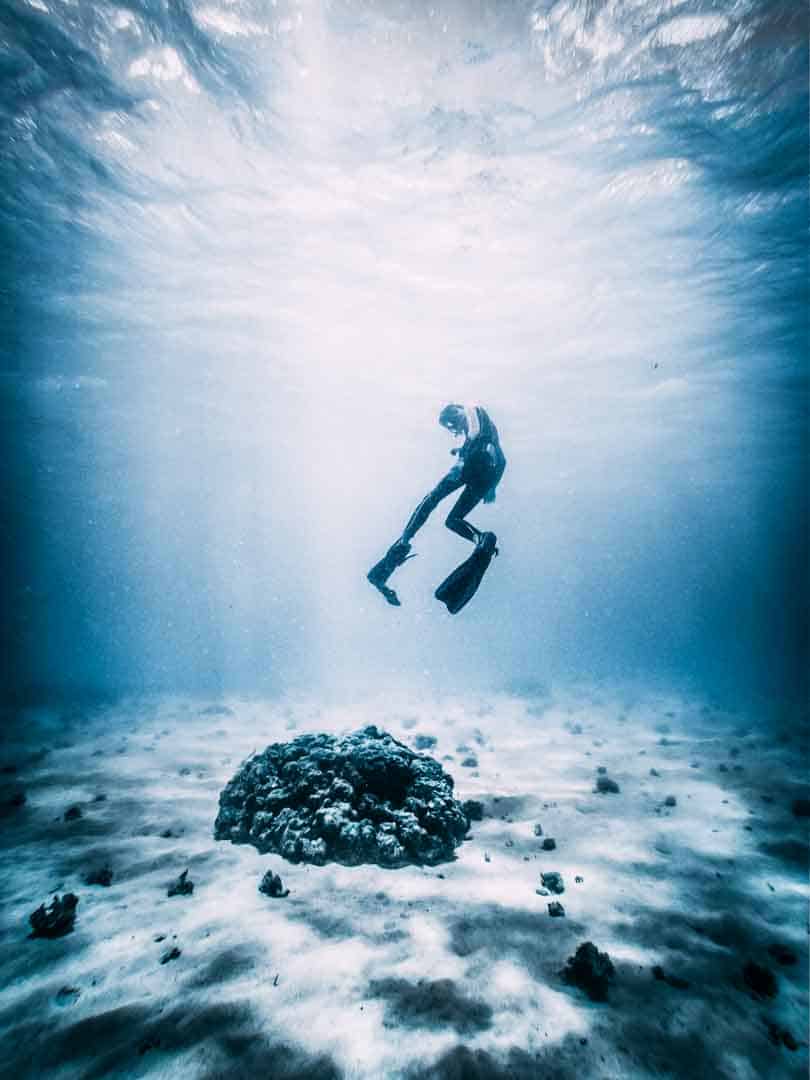Neoprene socks are designed to protect your feet when in the water, whether that’s scuba diving, snorkeling, free diving or walking along the sea-floor. Just as regular socks prevent chafing against your shoes, neoprene socks for snorkeling can be worn beneath your fins for the same purpose. They’re a simple way of avoiding blisters forming when the fins rub against the back of your heel or the sides of the feet.
But while standard socks help to absorb perspiration and keep your feet dry, neoprene socks are designed to prevent body heat loss through the feet by keeping them warm. They’re a particularly important accessory if you’re diving in cool and cold water conditions where you’re likely to lose body heat to the surrounding water through your extremities (feet, hands, and head). This can quickly lead to a lowered core body temperature and (in the worst-case scenario) hypothermia. Neoprene snorkel socks and divers socks might appear to be a simple garment, but they can help to trap your body’s heat in the lower extremities and keep heat loss to an absolute minimum.
BEST NEOPRENE SOCKS IN 2023
- SLINX Neoprene Water Socks
- OMGEAR Neoprene Water Socks
- AQUA LUNG Ergo Low Top Socks
- SEAVENGER Zephyr 3mm Neoprene Dive Socks
- FUN TOES Neoprene Socks
- CRESSI Short Premium Neoprene Diving Socks 3mm
- TILOS 3mm Waterproof Neoprene Fin Socks
- NEOSPORT Wetsuits Premium Neoprene 2mm
- REHAFFE Neoprene Diving Socks 3mm
- SCUBAMAX 3mm Low Cut Neoprene Socks
ALL THE NEOPRENE SOCKS THAT WE TESTED
SLINX Neoprene Water Socks
General Impression
The SLINX Neoprene water socks are made from 3mm high-quality Neoprene with glued and stitched seams, for maximum comfort and extra durability. They have a honeycomb non-slip texture on the bottom to ensure a better overall grip. One thing to keep in mind with these socks is that the sizes can be a bit smaller than usual, so make sure to measure well before you order them.
Specifications
SEX: Unisex (Sized for men)
THICKNESS: 3 mm
PROS
- High-quality 3mm Neoprene
- Honeycomb non-slip texture for better grip
CONS
- Sizing inconsistent
OMGEAR Neoprene Water Socks
General Impression
The OMGear Neoprene water socks are made from 3mm and 5 mm thick soft neoprene and laminated with 4-way stretchy nylon for extra durability and comfort. It also comes in low and high-cut versions, as well as multiple colors. They have a non-slip sole to prevent you from slipping as well as a velcro strap on top to prevent any sand from coming inside. The water socks are great for most swimming activities and can be worn with fins. Do keep in mind that the low-cut socks may not be suitable with closed heel fins as they might cause chafing.
Specifications
SEX: Unisex
THICKNESS: 3/5 mm
PROS
- 3mm and 5mm thickness
- Velcro strap and reinforced non-slip sole
- Flatlock stitching for extra durability
CONS
- Not suitable for closed heel fins
AQUA LUNG Ergo Low Top Socks
General Impression
Aqua Lung’s Ergo socks have a very simple design, yet are very comfortable on the foot. The low-cut design makes them ideal for open-heel fins. The sole has a silicone print grip to prevent you from slipping, but you can also get them with no print if you prefer. It features glued and stitched seams, which means you’re looking to wear these socks when snorkeling for a long time.
Specifications
SEX: Unisex (Sized for men)
THICKNESS: 3 mm
PROS
- Low-cut 3mm design
- Silicone print grip
CONS
- Low top if you prefer high top
SEAVENGER Zephyr 3mm Neoprene Dive Socks
General Impression
Constructed from a high-quality 3mm neoprene rubber, these Seavenger neoprene fin socks are ideal for snorkeling and diving in both warm and cool water conditions. They’ve been glued and blind-stitched to minimize the flow of water, as well as to ensure they’re wearable for many years to come.
Despite the sturdy stitching, they’re easy to slip on and off thanks to the 4-way stretchable material that responds to the contours of your feet. These diving socks or snorkel fin socks have been created with a dotted silk-screen sole for extra traction on land, making them ideal for a range of water sports where you want that little bit of added insulation at your extremities.
They’re sized from XS to XXXL, with the small designed for men’s size 6 to 7 and women’s 7 to 8 while the large will fit men’s 9 to 10 and women’s 11 to 12.
Specifications
SEX: Unisex
THICKNESS: 3 mm
PROS
- 3mm neoprene to help conserve body heat in cool water conditions
- 4-way stretch material for the ultimate in comfort
- Dotted silk-screen sole to prevent slips and falls
CONS
- Not durable
FUN TOES Neoprene Socks
General Impression
These 2.5mm neoprene socks have been designed with extra-thick soles to assist when walking in water and on slippery boat decks, as well as for use when jet skiing, paddling, and kayaking. They feature just two major stitch paths to decrease water friction and drag while being thin enough to wear beneath your snorkeling and dive fins for added warmth and protection against chafing.
It’s important to remember that these neoprene water socks are not designed for walking along cement pavements or rough surfaces such as rocks, as these will easily damage the thin sole. They are, however, created for everyone (men, women, and kids), with the small size designed for kids shoe sizes 4.5 to 6 and women 6.5 to 7. Men are accommodated with the medium to X-large sizes, which correspond to a range in shoe sizes from 7 to 12.5.
Specifications
SEX: Unisex
THICKNESS: 2.5 mm
PROS
- Constructed from a 2.5mm reinforced neoprene material
- Minimal stitch paths to reduce water friction
- Low-top design for warm water conditions
- Sized to fit men, women, and kids
CONS
- Thin sole
CRESSI Short Premium Neoprene Diving Socks 3mm
General Impression
Another mid-cut option that’s proven popular with snorkelers and swimmers are these Cressi neoprene diving socks, made by one of the dive world’s most trusted brands. They’re a great option for wearing beneath either full-foot or open-heeled fins (without having to worry about strap chafing on the upper heel) and are designed with a 3mm neoprene for use in either warm or cool-water conditions.
The durable rubber sole features a grip design and anti-slip properties for slippery docks, ladders and boat jetties while the glued-and-sewn seams ensure strength and durability. Cressi knows their international reach, so they’ve also published a size conversion chart for both US and EU sizes to help buyers find the neoprene sock size that’s right for them.
Specifications
SEX: Unisex (sized for men)
THICKNESS: 3 mm
PROS
- Constructed from a 3mm neoprene in a convenient mid-cut design
- Anti-slip rubber sole to prevent falls
- Can be worn beneath full-foot or open-heeled fins
- Strong glued-and-sewn seams for long-term durability
CONS
- Stitching failures reported
TILOS 3mm Waterproof Neoprene Fin Socks
General Impression
Ideal for those with sensitive skin, these 3mm neoprene socks are hypoallergenic and constructed from an exclusive X-Foam formula that’s made from limestone, rather than petroleum. They feature a mid-cut design that sits just above the ankles, protecting them against chafing from snorkel and dive fins, and making these swim socks for fins a good compromise between the standard low-cut and high-cut options.
The 4-way stretch neoprene forms around the contours of your feet for the ultimate in comfort and (combined with the flat-stitched and glued seams) won’t let water flow inside. Aside from the dotted silk-screen sole to prevent slips on land or while walking underwater, these Tilos neoprene socks are also more breathable than some, helping to avoid clammy feet during long periods of wear.
Specifications
SEX: Unisex (sized for men)
THICKNESS: 3 mm
PROS
- Constructed from a hypoallergenic neoprene that’s petroleum-free
- Non-slip dotted silk-screen sole that’s abrasion and tear resistant
- Glued and flat-stitched seams to minimize water flow and friction
- 4-way stretch neoprene that fits snugly around your feet.
- Breathable material for long-term wear
CONS
- Sizing inconsistent
NEOSPORT Wetsuits Premium Neoprene 2mm
General Impression
Constructed from ultra-soft, 4-way stretch neoprene, these 2mm neoprene socks tick all the right boxes if you want to keep your feet warm and prevent abrasions in warm or temperate waters. They slip on easily and will stop chafing from your snorkeling or diving fins, with a durable traction sole to ensure you won’t slip while walking around on the boat deck or shore.
Whether you’re wearing them for snorkeling, diving or a range of other water sports, these neoprene booties offer good heat retention without the bulk of thicker neoprene socks. It’s also possible to wear them beneath your wetsuit boots for an added layer of warmth in very cold water conditions.
Again, these thin neoprene socks are usually sized for men, so women need to take care when ordering. You can also select between a high-top or low-top design, depending on whether you’ll be exposed to warm, tropical waters or are diving and snorkeling in cool-water conditions and want a little extra protection.
Specifications
SEX: Unisex (sized for men)
THICKNESS: 2 mm
PROS
- Available in a high-top or low-top design to meet your needs
- Constructed from a soft 4-way stretch 2mm neoprene
- Durable traction sole to prevent slipping
CONS
- Sizing inconsistent
REHAFFE Neoprene Diving Socks 3mm
General Impression
With the addition of a velcro strap and buckle around the top, these high-top neoprene dive socks are boot-like in their design while still offering flexibility and softness. They can be fastened as tight as you like to prevent water and debris intrusion, with the option to fit them over the top of or beneath your wetsuit.
The 3mm fabric of these water-resistant socks makes them a good option for warm or cool water snorkeling and diving, with the socks thin enough to be worn beneath your fins. Put them on beneath either full-foot or open-heeled fins, without having to worry about chafing as the strap creeps up your heel.
There’s a non-slip sole to prevent slipping in wet areas, together with ruggedly sewn and glued seams to stop any sand from getting through. These ReHaffe 3mm neoprene socks are designed for men, women, and kids, with size charts available online to help in figuring out which is right for you.
Specifications
SEX: Unisex
THICKNESS: 1.5 mm
PROS
- 5 color options
- Durable Amara leather protection
- Sizes 2XS to 2XL for all ages
- Designed to fit the natural curve of the hand
CONS
- Sizing inconsistent
SCUBAMAX 3mm Low Cut Neoprene Socks
General Impression
With a loyal following of scuba divers who rave about their comfortable fit, these ScubaMax neoprene dive socks are constructed from a 3mm neoprene for both warm and cool-water conditions. The soft material perfectly molds around the feet, being not too tight but also not so loose that water can filter in.
Functioning as diving socks or snorkel booties, they slip on easily thanks to their low-cut design and are perfect for wearing beneath fins. That being said, they’re not really suitable if you’re using open-heeled fins with straps that tend to creep up the ankle.
Aside from being used with fins, these neoprene socks can be used for walking in the sand or through the water, although the lack of an anti-slip sole means users should be cautious when using them on slippery boat decks or jetties.
Specifications
BRAND: SAMSFX
INCLUDES: Pliers, sheath, lanyard, clippers, quick tie tool
CONSTRUCTION: Aluminum
GRIP: Smooth metal handle
CUTTING OPTIONS: Tungsten carbide blade cuts through mono, fluoro, and braid
NOSE LENGTH: Short needle-nose
BEST SUITED FOR: Bass and sportfish angling
PROS
- Constructed from a 3mm soft neoprene that’s incredibly comfortable
- Slip on and off easily due to a low-cut design
- Prevent chafing when worn with closed-heel snorkeling and dive fins
CONS
- No anti-slip
BEST NEOPRENE SOCKS
Buyer's Guide
How do neoprene socks differ from water shoes and dive booties?
When shopping for neoprene snorkeling fin socks, you might be wondering how they are different from dive booties or water shoes. They both look similar and function to protect your feet, but they have some key differentiators that make one more suited to certain situations than another.
Sole
Water shoes generally come with a hard rubber sole that makes them favorable for walking on the sea-floor, along river beds or wading through lakes. The hard sole will protect your feet from sharp rocks and other objects below while providing some level of grip.
Neoprene fin socks and snorkeling socks, on the other hand, don’t have a hard rubber sole and tend to be more flexible. They’re designed to be worn inside of your fins as an extra level of protection against the cold and chafing, rather than as a “shoe”.
That being said, some neoprene water socks for snorkeling will come with a hardened neoprene sole with anti-slip properties to aid in navigating slippery boat decks and jetties. However, these soles still tend to be more flexible than the rubber soles you’d find on water shoes, which are better suited to walking on hard surfaces. Prolonged use of neoprene socks on rocks or cement walkways will quickly wear the soles down and damage them.
Zippered sides
Some water shoes and dive booties will come with zippered sides to make getting them on and off easier, a feature that’s not normally seen in neoprene socks. On the other hand, most neoprene scuba diving socks are flexible enough to slip on and off simply. This makes them a more convenient option if you’re just after a bit of extra protection beneath your fins. The lack of a zippered side also means they’re less sus-ceptible to water or other debris seeping in.
Aqua mesh
Some water shoes will come with an aqua mesh netting that helps to prevent sand and other underwater debris from filtering in. Neoprene socks, on the other hand, are usually completely covered in an opaque material, with blind-stitched seams to prevent water or other sediment getting in. If unwanted material does get in, you will need to remove the socks altogether and rinse them out.
Breathability and heat retention
The aqua mesh on water booties for snorkeling allows air to flow in and out, making them more breathable when compared to neoprene socks. But if keeping your feet warm is the intention, then the reduced breathability of neoprene socks also enables them to retain heat much better.
Some neoprene socks made from advanced tech materials offer added breathability and tend to be at the higher end of the price range. These are worth investing in if you spend extended periods underwater wearing your neoprene socks and want to eliminate getting clammy feet.
How to care for your neoprene socks
If you want your neoprene socks to have a long life, it’s important that you care for them appropriately. This means rinsing them with fresh water after every use to re-move any sediments, bacteria and/or microorganisms, as well as foot perspiration that might otherwise lead to bad odors in your socks.
After rinsing your neoprene soaks or soaking them in a bucket of fresh water (this may contain soap or detergent specially formulated for neoprene), rub and squeeze them to remove any contaminants. Then rinse again and squeeze all the water from them before hanging or laying them out to dry.
It’s important that you avoid drying them in direct sunlight, which can damage the neoprene and result in it becoming brittle. Instead, air dry them as you would your wetsuit in a protected area away from direct sun.
Neoprene sock thickness
Neoprene socks are available in a variety of thicknesses, ranging anywhere from 1mm to 5mm. Thinner neoprene socks are suitable for snorkeling and diving in warm, tropical waters when you want your feet to remain relatively cool while thicker socks are designed for cold-water conditions when you want to avoid heat loss.
If you’re purchasing thick neoprene socks, take into consideration the size of your fins to ensure they will allow for the extra thickness, without cramping your feet. This is more of an issue with full-foot fins than open-heeled fins, as the latter can be adjusted using their strap to accommodate thick neoprene socks.
Neoprene sock length
Aside from varying thicknesses, neoprene socks also come in different lengths, in-cluding ankle socks and those that are designed to sit above the ankle bone. Ankle socks are a good option if you’re looking for minimal protection and don’t want to end up with an unsightly sock tan. They can also be easier to slip on and off your feet.
Longer socks may provide better protection against blisters if you’re wearing them beneath open-heeled fins, as they will prevent the back of the fins rubbing on your ankle. Higher length socks will also offer greater protection against heat loss, keeping the lower part of your calves warm. They can also function as an extra level of coverage against jellyfish stings or other underwater creatures that may sting, scratch or bite. If you’re wearing a full-length wetsuit, a pair of high-cut socks can be positioned beneath your wetsuit to create a tight water seal and ensure no skin is showing.
Aside from low-cut and high-cut neoprene socks, you can also find mid-cut designs that are a good compromise between the two. If you use open-heeled fins but don’t want a high-cut sock, then the mid-cut option is ideal. It provides just enough coverage in case your fin strap rides up your heel while being easier to slip on and off when compared to a high-cut design.
BEST NEOPRENE SOCKS
FAQs
1. What are neoprene socks?
Neoprene socks are made from a synthetic rubber material that’s renowned for its ability to maintain flexibility over a wide range of temperatures. It’s a popular mate-rial for making clothing for aquatic and underwater activities, including wetsuits, hoodies, gloves, and booties, as well as neoprene socks. Some neoprene socks also incorporate spandex to allow for greater flexibility, as well as high-tech materials that are renowned for their breathability.
2. What are neoprene socks used for?
Neoprene socks are designed to offer some level of protection against the cold and are often worn beneath fins during snorkeling and diving. They can help to prevent chafing of fins against the ankle and sides of feet, as well as providing protection against external irritants or dangers, such as stinging jellyfish, sharp rocks and coral. Many neoprene socks also come with an anti-slip sole to help their wearers navigate slippery boat docks, decks, and ladders.
3. Neoprene socks vs. water shoes
Neoprene socks are similar to water shoes in many ways, but there are also some key differentiating factors. Water shoes and booties generally come with a hard rubber sole that protects the wearer against rocks and rough surfaces on the sea-floor while neoprene socks are usually soft and flexible on their soles. This makes them more suited to being worn beneath fins for either snorkeling or diving and much easier to slip on and off when compared to water shoes.
While neoprene socks tend to feature an all-in-one-design, water shoes may have zippered sides that make getting them on and off easier, as well as an aqua mesh net-ting. This helps to prevent unwanted debris such as sand or pebbles from filtering into the shoe while also making them more breathable. Water shoes and neoprene socks without mesh tend to offer better heat retention, making them ideal for snorkeling and diving in cold-water conditions.
4. How do you wash and clean neoprene socks?
Caring for your neoprene socks is essential if you want them to have a long life. This means rinsing them properly after every use with fresh water to eliminate any saltwater, sediments, or bacteria that might have a negative impact on the material if left to decay. You may opt to use a specially formulated soap or detergent that’s designed to be used with neoprene or simply freshwater if that’s what’s readily available.
Simply soak your neoprene soaks in a bucket of freshwater and give them a slight rub and squeeze, then rinse them again. All of the remaining water should then be rung out of them, and they should be left somewhere protected to dry. Avoid hanging them in direct sunlight, as this can damage the neoprene and cause it to become dry and brittle.
5. What thickness of neoprene socks should I buy?
The thickness of neoprene sock that’s right for you will depend on the water condi-tions you’re predominantly snorkeling or diving in. For example, if you’re doing aquatic activities in warm, tropical waters, then a pair of 1mm or 2mm neoprene socks will do the job. If you’re looking for a bit of extra warmth in temperate waters, then you might prefer socks that are 3mm or 4mm thick. Cold-water divers will probably want to invest in 5mm neoprene socks that will offer the best heat retention qualities.
6. What is a 4-way stretch?
Neoprene socks with a 4-way stretch mean that they will stretch in all directions, of-fering a snug fit around your feet. The material can be stretched to the front, back, left or right, so no matter what shape your feet are, they will respond to the contours to create a complete seal.
Everyone’s feet are slightly different in size and shape, so a 4-way stretch enables the socks to accommodate the uniqueness of every diver’s or snorkeler’s feet. They will mold perfectly over your feet so that there are no unwanted pockets of air that might allow water to filter in or sediment that could lead to irritation, rashes, and blisters.
7. Where to buy neoprene socks
Most scuba diving and snorkeling shops will offer a limited choice of neoprene socks from select brands. But if you want the biggest range, online platforms such as Amazon will offer a more extensive collection from a variety of different brands. One of the benefits of buying online is being able to read neoprene sock reviews from previous buyers to see how they perform in real-life conditions. You can compare the features of different neoprene socks and their prices to find the one that’s right for you.
8. Are neoprene socks waterproof?
Yes, neoprene socks are waterproof, as well as being resistant to heat and oil. Gas bubbles exist within the neoprene and absorb a small amount of water when you’re snorkeling or diving. It’s this water that keeps you warm, as it’s heated by your own body heat. The seams of neoprene socks are also stitched and glued to ensure they are waterproof and ultra-resistant against any water seeping in. If water does seep in, it’s probably from around the heel of the sock, which can occur if they are loosely fitted.
9. Does neoprene stretch?
Neoprene is a relatively stretchy material that can expand significantly when being donned before returning to its original size and shape. But unlike some other materi-als, neoprene shouldn’t stretch out of shape over time so that it becomes saggy.
Ideally, neoprene socks should fit snuggly, without being so tight that they interfere with your foot’s circulation. Most neoprene socks will “give” a little bit once they are exposed to water and will bunch up slightly when dry.
10. What does neoprene feel like?
Neoprene is soft to the touch, with a cushiony and slightly springy feel. You can press into neoprene with your finger, and it should return almost immediately to its original shape when you remove the pressure.
11. How do I choose the best waterproof socks?
The best neoprene socks for you will depend on what you are using them for and the aquatic conditions you’re most commonly exposed to. Neoprene ankle socks are ideal if you just want a little bit of protection in warm-water conditions and don’t want to end up with a visible sock tan while snorkeling.
Neoprene socks that cover the ankle are a better option for diving or snorkeling when you want additional protection, whether that be from stinging jellyfish or cold water. They’re also ideal if you usually wear open-heeled fins, as they will prevent chafing on the upper ankle if your fin strap rides up.
An additional factor to consider when deciding on the best neoprene socks for you is their thickness, with a thicker sock better at retaining heat loss in cold-water conditions. 1mm, 2mm, and 3mm neoprene socks will do the job in warm or even cool water, but you’ll probably want to invest in 4mm or 5mm neoprene socks for cold-water conditions.
REACH OUT
As always, we create our content with you, fellow adventurers, in mind. So, how’d we do? Did you find this informative? Did it help you make a decision? Did we miss anything? We’d love to hear from you below. Thanks for reading and we hope your next adventure is a great one!





































